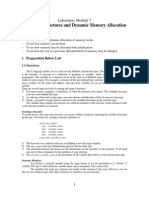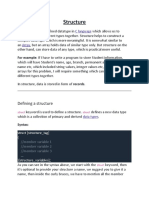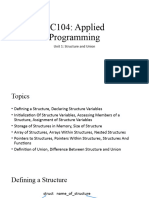0 ratings0% found this document useful (0 votes) 56 views14 pagesC Structure
Copyright
© © All Rights Reserved
We take content rights seriously. If you suspect this is your content,
claim it here.
Available Formats
Download as PDF or read online on Scribd
C Structures
Read) (_Courses
The structure in C is a user-defined data type that can be used to group
Cra) C roe)
(Practice) (video) (sobs )
items of possibly different types into a single type. The struct keyword is
used to define the structure in the C programming language. The items in
the structure are called its member and they can be of any valid data type
Structure in C
Struct keyword relat kets
struct geeksforgeeks
a
char __name [10:
aC TET, eae
float salary;
C Structure Declaration
We have to declare structure in C before using it in our program. In structure
declaration, we specify its member variables along with their datatype. We
can use the struct keyword to declare the structure in C using the following
syntax:�struct structure_name {
data_type member_name1;
data_type member_name1;
&
The above syntax is also called a structure template or structure prototype
and no memory is allocated to the structure in the declaration.
C Structure Definition
To use structure in our program, we have to define its instance. We can do
that by creating variables of the structure type. We can define structure
variables using two methods:
1. Structure Variable Declaration with Structure Template
struct structure_name {
data_type member_name1;
data_type member_name1;
}variable1, varaible2,
2. Structure Variable Declaration after Structure Template
// structure declared beforehand�struct structure_name variable1, variable2, ..
Access Structure Members
We can access structure members by using the (_..) dot operator.
Syntax
structure_name.member1;
strcuture_name.member2;
In the case where we have a pointer to the structure, we can also use the
arrow operator to access the members.
Initialize Structure Members
Structure members cannot be initialized with the declaration. For example,
the following C program fails in the compilation
struct Point
{
int x
®; // COMPILER ERROR: cannot initialize members here
®; // COMPILER ERROR: cannot initialize members here
int y
%
The reason for the above error is simple. When a datatype is declared, no
memory is allocated for it. Memory is allocated only when variables are
created.
We can initialize structure members in 3 ways which are as follows:
1. Using Assignment Operator.
2. Using Initializer List.
3. Using Designated Initializer List.
\/ 1 Initialization using Assignment Operator
struct structure_name str;
str.member1 = value1;
str.member2 = value2;
str.member3 = value3;�2. Initialization using Initializer List
struct structure_name str = { valuel, value2, value3 };
In this type of initialization, the values are assigned in sequential order as
they are declared in the structure template.
3. Initialization using Designated Initializer List
\- ges
Designated Initialization allows structure members to be initialized in any
order. This feature has been added in the C99 standard.
struct structure_name str = { .member1 = valuel, .member2 = value2,
-member3 = value3 };
The Designated Initialization is only supported in C but not in C++.
Example of Structure in C
The following C program shows how to use structures
c
// © program to illustrate the use of structures
include
// declaring structure with name str1
struct stri {
int 45
char c;
float f;
char s(30];
u
// declaring structure with name str2
struct str2 {
int ii;
char ce;
float ff;
} var; // variable declaration with structure template
// river code�int main()
t
// variable declaration after structure template
// initialization with initializer list and designated
// initializer list
struct stri vari = { 1,
var25
struct str2 var3 = { .ff = 5.00, .ii = 5, .cc = ‘a! }5
A‘, 1.8, "GeeksforGeeks” },
// copying structure using assignment operator
var2 = vart;
print#("Struct 1:\n\ti = Xd, ¢ = Kc, f = BF, 5
varl.i, varl.c, varl.f, vari.s);
printf("Struct 2:\n\ti = %d, ¢ = Xc, f = Xf, s = Xs\n",
var2.i, var2.c, var2.f, var2.s)5
print#("Struct 3\n\ti = %d, ¢ = Kc, f = XF\n", var3.ii
var3.cc, var3.ff);
Xs\n",
return 0;
Output
Struct 1:
i=1, c= A, f = 1.000000, s = GeeksforGeeks
Struct 2:
1.000000, s
GeeksforGeeks
5.200000
typedef for Structures
The typedef keyword is used to define an alias for the already existing
datatype. In structures, we have to use the struct keyword along with the
structure name to define the variables. Sometimes, this increases the length
and complexity of the code. We can use the typedef to define some new
shorter name for the structure.
Example
c�// © Program to illustrate the use of typedef with
// structures
#include
// defining structure
struct str1 {
int a;
ub
// defining new name for str1
typedef struct str stra;
// another way of using typedef with structures
typedef struct str2 {
int x;
} str2;
int main()
t
// creating structure variables using new names
str1 varl = { 28 };
str2 var2 = { 314 }5
printf("vart.a
print#(*var2.x
Xd\n", vard.a);
Bd", var2.x)5
return @;
Output
varl.a = 20
314
var2.x
Nested Structures
C language allows us to insert one structure into another as a member. This
process is called nesting and such structures are called nested structures.
There are two ways in which we can nest one structure into another:
1. Embedded Structure Nesting
In this method, the structure being nested is also declared inside the parent
structure.�Example
struct parent {
int member1;
struct member_str member2 {
int member_stri;
char member_str2;
2. Separate Structure Nesting
In this method, two structures are declared separately and then the member
structure is nested inside the parent structure.
Example
struct member_str {
int member_str1;
char member_str2;
struct parent {
int member1;
struct member_str member2;
One thing to note here is that the declaration of the structure should always
be present before its definition as a structure member. For example, the
declaration below is invalid as the struct mem is not defined when it is
declared inside the parent structure.
struct parent {
struct mem a;
%
struct mem (�int var;
3
Accessing Nested Members
We can access nested Members by using the same (. ) dot operator two
times as shown:
str_parent.str_child.member;
Example of Structure Nesting
c
// © Program to illustrate structure nesting along with
// forward declaration
include
// child structure declaration
struct child {
int x;
char c;
us
// parent structure declaration
struct parent {
int a;
struct child bs
// driver code
int main()
t
struct parent varl = { 25, 195,
// accessing and printing nested members
printf("varl.a = d\n", vard.a);
printf(*varl.b.x = %d\n", vard.b.x)5
printf(*vari.b.c = %c", vart.b.c);
return 0;�Output
varl.a = 25
vari.b.x = 195
varl.b.c = A
Structure Pointer in C
We can define a pointer that points to the structure like any other variable.
Such pointers are generally called Structure Pointers. We can access the
members of the structure pointed by the structure pointer using the (=>)
arrow operator.
Example of Structure Pointer
c
// © program to illustrate the structure pointer
include
// steucture declaration
struct Point {
int x, y3
int main()
{
struct Point str = (1, 2 }5
// p2 is a pointer to structure pt
struct Point* ptr = astr;
// Accessing structure members using structure pointer
printé("%d %d", ptr->x, ptr->y);
return @;
y
Output�L-Getr- Referential Structures
L TI The sel
eferential structures in C are those structures that contain
references to the same type as themselves i.e. they contain a member of the
type pointer pointing to the same structure type.
Example of Self-Referential Structures
struct structure_name {
data_type member1;
data_type member2;
struct structure_name* str;
Cc
// © program to illustrate the self referential structures
#include
// structure template
typedef struct str {
int mem;
int mem2;
struct str* next;
ystr;
// driver code
int main()
{
str vara = (1, 2, NULL }5
str var2 = { 10, 20, NULL };
// assigning the address of var2 to vari.next
vard.next = &var2;
// pointer to vard
str ptr = avart;
// accessing var2 menbers using var1
printf("var2.men1: %d\nvar2.men2: %d", ptrd-snext->mem1,
ptri-snext->men2);
return @;�Output
var2.mem1: 10
var2.mem2: 20
Such kinds of structures are used in different data structures such as to
define the nodes of linked lists, trees, etc. 7)
C Structure Padding and Packing
“Technically, the size of the structure in C should be the sum of the sizes ofits
:
structure
: a
1. Using #pragma pack(1)
2. Using __attribute((packed))__
Example of Structure Padding and Packing
fa}
// © program to illustrate structure padding and packing
#include
// structure with padding
struct str {
char 5
int i;
ub
struct str2 {
char cs
int i;
} _attribute((packed)) __; // using structure packing�// driver code
int main()
t
printf ("Size of str: %d\n", sizeof(struct str1));
printf("Size of str2: %d\n", sizeof(struct str2));
return 03
Output
Size of stri: 8
Size of str2: 5
As we can see, the size of the structure is varied when structure packing is
performed.
To know more about structure padding and packing, refer to this article
Structure Member Alignment, Padding and Data Packing.
Fields
90% Refund @Courses C CBasics CDataTypes COperators Cinputand Output CControlFlow
WE HSH WE RUW WHE HHOAIHUIT SoHYuH UF Une HHEHWEH We Lar Use WIE HWS
specify the size and reduce memory consumption.
Syntax of Bit Fields
struct structure_name {
data_type menber_name: width of bit-field;
&
Example of Bit Fields
c
J/ © Program to illustrate bit fields in structures
include
// declaring structure for reference
struct str {�int a;
char c;
‘
// structure with bit fields
struct str2 {
int a : 24; // size of ‘a’ is 3 bytes = 24 bits
char c;
u
// driver code
int main()
{
printf("Size of Str1: %d\nSize of str2: %¢",
sizeof(struct str1), sizeof(struct str2));
return 05
Output
Size of Stri: 8
Size of Str2: 4
As we can see, the size of the structure is reduced when using the bit field to
define the max size of the member ‘a’.
Uses of Structure in C
C structures are used for the following:
1. The structure can be used to define the custom data types that can be
used to create some complex data types such as dates, time, complex
numbers, etc. which are not present in the language.
2. It can also be used in data organization where a large amount of data can
be stored in different fields
3. Structures are used to create data structures such as trees, linked lists,
etc.
4. They can also be used for returning multiple values from a function.
Limitations of C Structures
In C language, structures provide a method for packing together data of
different types. A Structure is a helpful tool to handle a group of logically�related data items. However, C structures also have some limitations.
+ Higher Memory Consumption: It is due to structure padding.
+ No Data Hiding: C Structures do not permit data hiding. Structure
members can be accessed by any function, anywhere in the scope of the
structure.
+ Functions inside Structure: C structures do not permit functions inside
the structure so we cannot provide the associated functions.
* Static Members: C Structure cannot have static members inside its body.
* Construction creation in Structure: Structures in C cannot have a
constructor inside Structures.
Related Articles
* C Structures vs C++ Structure
Whether you're preparing for your first job interview or aiming to upskill in
this ever-evolving tech landscape, GeeksforGeeks Courses are your key to
success. We provide top-quality content at affordable prices, all geared
towards accelerating your growth in a time-bound manner. Join the millions
we've already empowered, and we're here to do the same for you. Don't
miss out - check it out now!
Get paid for your published articles and stand a chance to win tablet, smartwatch
and exclusive GfG goodies! Submit your entries in Dev Scripter 2024 today
Participate in Three 90 Challenge! Enroll in any GeeksforGeeks course and get 90%
refund by completing 90% course. Explore offer now.
Last Updated : 06 May, 2023 an.
Previous Next
restrict keyword in C dot (.) Operator in C
Share your thoughts in the comments $d Your Comme

























































